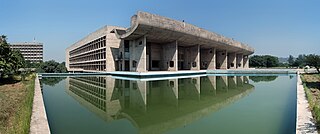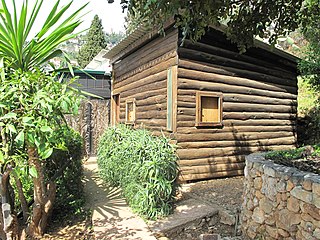| UNESCO World Heritage Site | |
|---|---|
| Includes | 17 sites on three continents |
| Criteria | Cultural: (i)(ii)(vi) |
| Reference | 1321rev |
| Inscription | 2016 (40th Session) |
| Area | 98.5 ha (0.380 sq mi) |
| Buffer zone | 1,409.4 ha (5.442 sq mi) |
The Architectural Work of Le Corbusier, an Outstanding Contribution to the Modern Movement is a World Heritage Site consisting of a selection of 17 building projects in several countries by the Franco-Swiss architect Le Corbusier. [1] These sites demonstrate how Modern Movement architecture was applied to respond to the needs of society and show the global range of a style and an architect. [2]

The International Style or internationalism is a major architectural style that was developed in the 1920s and 1930s and was closely related to modernism and modernist architecture. It was first defined by Museum of Modern Art curators Henry-Russell Hitchcock and Philip Johnson in 1932, based on works of architecture from the 1920s. The terms rationalist architecture and modern movement are often used interchangeably with International Style, although the former is mostly used in the English-speaking world to specifically refer to the Italian rationalism, or even the International Style that developed in Europe as a whole.

Notre-Dame du Haut is a Roman Catholic chapel in Ronchamp, France. Built in 1955, it is one of the finest examples of the architecture of Franco-Swiss architect Le Corbusier. The chapel is a working religious building and is under the guardianship of the private foundation Association de l’Œuvre de Notre-Dame du Haut. It attracts 80,000 visitors each year. In 2016, it was inscribed on the UNESCO World Heritage List in along with sixteen other works by Le Corbusier, because of its importance to the development of modernist architecture.

Sainte Marie de La Tourette is a Dominican Order priory, located on a hillside near Lyon, France, designed by the architect Le Corbusier, the architect’s final building. The design of the building began in May 1953 and completed in 1961. The committee that decided the creation of the building considered that the primary duty of the monastery should be the spiritual awakening of the people and in particular the inhabitants of nearby areas. As a result, the monastery was constructed in Eveux-sur-Arbresle, which is just 25 km from Lyon and is accessible by train or car.

The Weissenhof Estate is a housing estate built for the 1927 Deutscher Werkbund exhibition in Stuttgart, Germany. It was an international showcase of modern architecture's aspiration to provide cheap, simple, efficient, and good-quality housing.

The Curutchet House, La Plata, Argentina, is a building by Le Corbusier. It was commissioned by Dr. Pedro Domingo Curutchet, a surgeon, in 1948 and included a small medical office on the ground floor. The house consists of four main levels with a courtyard between the house and the clinic. The building faces the Paseo del Bosque park. The main facade incorporates a brise soleil.

The former Van Nelle Factory on the Schie in Rotterdam, is considered a prime example of the International Style based upon constructivist architecture. It has been a designated UNESCO World Heritage Site since 2014. Soon after it was built, prominent architects described the factory as "the most beautiful spectacle of the modern age" and "a poem in steel and glass".

The Palace of Assembly is a building in Chandigarh, India which houses the Punjab Legislative Assembly and the Haryana Legislative Assembly. It was designed by modernist architect Le Corbusier. It is part of the Capitol Complex, which includes the Legislative Assembly, Secretariat and High Court. The Palace of Assembly features a circular assembly chamber, a forum for conversation and transactions, and stair-free circulation.

The Cabanon de vacances is a vacation home designed and built by noted architect Le Corbusier in 1951. It is the only place the architect Le Corbusier built for himself which he used for vacation. In July 2016, the home and sixteen other works by Le Corbusier were inscribed as the world's smallest UNESCO World Heritage Sites. It was built exclusively for himself, as a seaside escape away from Parisian city life, Le Corbusier spent every August in the cabin for 14 years. The cabin is constructed out of wood logs. Le Corbusier loved his summer home for its location.
Le Corbusier's Five Points of Architecture is an architecture manifesto conceived by architect, Le Corbusier. It outlines five key principles of design that he considered to be the foundations of the modern architectural discipline, which would be expressed through much of his designs.

Chandigarh Capitol Complex, located in sector-1 of Chandigarh city in India, is a government compound designed by the architect Le Corbusier and is a UNESCO World Heritage Site. It is spread over an area of around 100 acres and is a prime manifestation of Chandigarh's architecture. It comprises three buildings: the Palace of Assembly or Legislative Assembly, Secretariat Building and the High Court plus four monuments and a lake. It was added to the UNESCO World Heritage Site List in 2016 along with sixteen other works by Le Corbusier for its contribution to the development of modernist architecture.
Immeuble Molitor is an apartment building designed by Le Corbusier and Pierre Jeanneret and built between 1931 and 1934. Located at the border between the city of Paris and the commune of Boulogne-Billancourt in France, it has been listed along with 16 other architectural works by Le Corbusier as a UNESCO World Heritage Site. Le Corbusier lived in the building from its completion until his death in 1965.

The Villa Le Lac, also known as the Villa "Le Lac" Le Corbusier, is a residential building on Lake Geneva in Corseaux, Canton of Vaud, Switzerland, designed by Swiss architects and cousins Le Corbusier and Pierre Jeanneret between 1923 and 1924 for Le Corbusier's parents. It is an example of residential Modern architecture and showcases three of Le Corbusier's Five Points of Architecture. The building is a designated Swiss Cultural Property of National Significance and was added to the UNESCO World Heritage List in 2016.
The Maison de la Culture de Firminy is a cultural establishment located in Firminy in the Loire region of France. The site was inscribed on the UNESCO World Heritage List in 2016 for its contribution to the development of modern architecture along with sixteen other works by Le Corbusier.
The Claude and Duval factory, is a factory located in Saint-Dié-des-Vosges, in the department of Vosges in France. The building is the only industrial building designed by Le Corbusier. In 2016, it was inscribed on the UNESCO World Heritage along with sixteen other works by Le Corbusier, because of its outstanding contribution to the development of modern architecture.